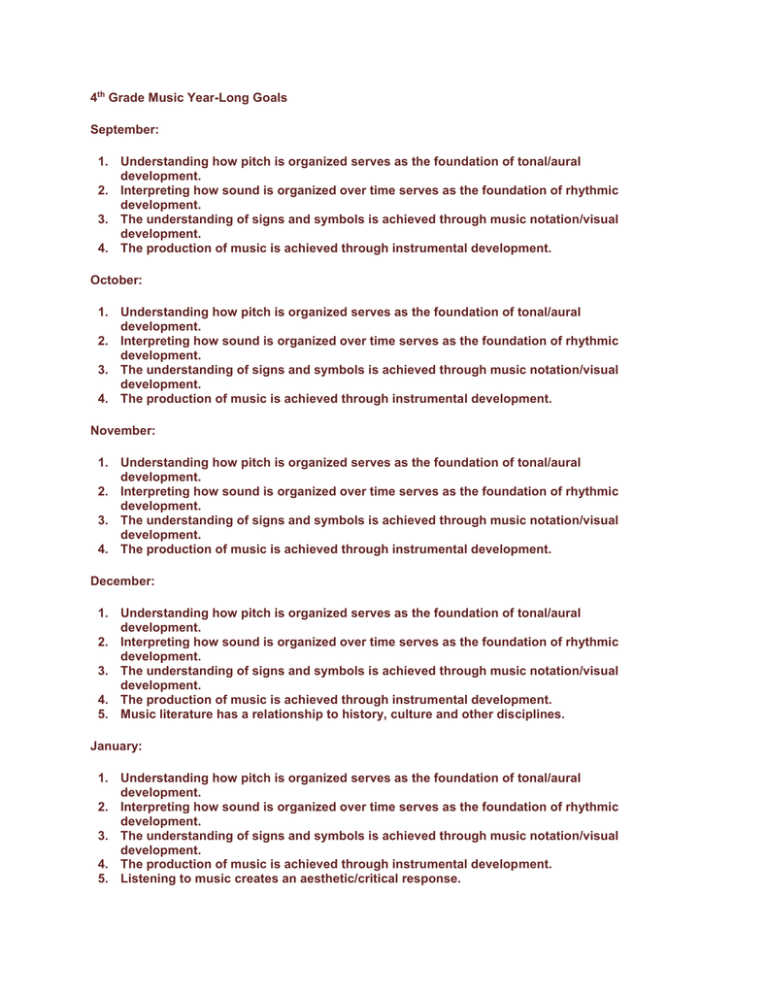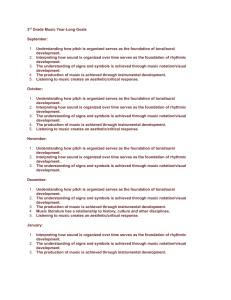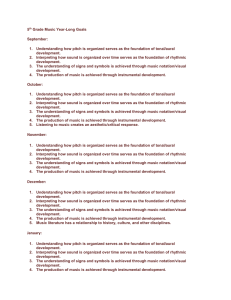4 Grade Music Year-Long Goals September:
advertisement

4th Grade Music Year-Long Goals September: 1. Understanding how pitch is organized serves as the foundation of tonal/aural development. 2. Interpreting how sound is organized over time serves as the foundation of rhythmic development. 3. The understanding of signs and symbols is achieved through music notation/visual development. 4. The production of music is achieved through instrumental development. October: 1. Understanding how pitch is organized serves as the foundation of tonal/aural development. 2. Interpreting how sound is organized over time serves as the foundation of rhythmic development. 3. The understanding of signs and symbols is achieved through music notation/visual development. 4. The production of music is achieved through instrumental development. November: 1. Understanding how pitch is organized serves as the foundation of tonal/aural development. 2. Interpreting how sound is organized over time serves as the foundation of rhythmic development. 3. The understanding of signs and symbols is achieved through music notation/visual development. 4. The production of music is achieved through instrumental development. December: 1. Understanding how pitch is organized serves as the foundation of tonal/aural development. 2. Interpreting how sound is organized over time serves as the foundation of rhythmic development. 3. The understanding of signs and symbols is achieved through music notation/visual development. 4. The production of music is achieved through instrumental development. 5. Music literature has a relationship to history, culture and other disciplines. January: 1. Understanding how pitch is organized serves as the foundation of tonal/aural development. 2. Interpreting how sound is organized over time serves as the foundation of rhythmic development. 3. The understanding of signs and symbols is achieved through music notation/visual development. 4. The production of music is achieved through instrumental development. 5. Listening to music creates an aesthetic/critical response. February: 1. Interpreting how sound is organized over time serves as the foundation of rhythmic development. 2. The understanding of signs and symbols is achieved through music notation/visual development. 3. The production of music is achieved through instrumental development. 4. Listening to music creates an aesthetic/critical response. March: 1. Understanding how pitch is organized serves as the foundation of tonal/aural development. 2. Interpreting how sound is organized over time serves as the foundation of rhythmic development. 3. The understanding of signs and symbols is achieved through music notation/visual development. 4. The production of music is achieved through instrumental development. 5. Listening to music creates an aesthetic/critical response. April: 1. The understanding of signs and symbols is achieved through music notation/visual development. 2. Listening to music creates an aesthetic/critical response. May: 1. Understanding how pitch is organized serves as the foundation of tonal/aural development. 2. The production of music is achieved through instrumental development. 3. Music literature has a relationship to history, culture and other disciplines.



